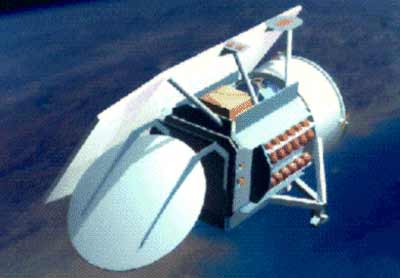Thank you very much for visiting Gunter's Space Page. I hope that this site is useful and informative for you.
If you appreciate the information provided on this site, please consider supporting my work by making a simple and secure donation via PayPal. Please help to run the website and keep everything free of charge. Thank you very much.
Ball: BCP-600

BCP-600 (GFO) [Ball]
Designed for Small Explorer (SMEX) Class Missions, the BCP-600 provides a costeffective solution when performance, high reliability and extended mission lifetime are important. The bus can operate in a wide range of orbits and can accept any type of instrumentation requiring precision pointing control and knowledge, with the flexibility for rapid target selection.
The BCP-600 configuration uses a simple, roughly cubical "Unibody" graphite epoxy/honeycomb structure. An internal 55 x 55 x 55-cm compartment can accommodate payload units and/or additional propellant tanks. The payload deck above the internal cavity provides a volume approximately 112 cm in diameter and 101 cm high, using the Pegasus XL launch vehicle fairing.
The power subsystem employs a fully redundant power control and distribution unit, a 20 amp-hour NiH2 battery with a spare cell, and four radially deployed solar array panels totaling about 2.4 m². A variety of alternate array configurations can be accommodated to support varying mission requirements and payload arrangements.
All units of the command and data handling (C&DH) subsystem are redundant. The spacecraft computer can be reprogrammed on orbit through software updates during normal operations. Multiple levels of save modes protect the entire bus from errors including software errors. Command and telemetry processing is handled in a dedicated unit with storage for 256 Mbits of engineering data. The architecture provides real-time command and telemetry functions even when the spacecraft computer is off. A solid-state recorder (SSR) with a capacity of up to 2 Gbits provides storage for payload data. The SSR can handle input rates up to 17 Mbps while simultaneously outputting up to 1 Mbps to the transmitter.
The bus RF uplink/downlink uses a STDNcompatible S-band transponder and two omni antennas for data transmission and reception for all bus attitudes. Payload data is downlinked at up to 2 Mbps; commands can be received at up to 2 Kbps.
The Attitude Determination and Control System (ADCS) uses redundant star trackers, inertial reference units, sun sensors and magnetometers for attitude determination. Four lowvibration reaction wheels and three torque rods with redundant windings and drivers are used for control, allowing the BCP 600 to handle all pointing orientations. Depending on payload inertial characteristics, the bus design provides a slew rate capability of up to 1 deg/s and angular acceleration capability of about 0.01 deg/s2.
The optional mono propellant blowdown propulsion module uses two tanks that can store up to 28 kg of hydrazine and eight 4-N thrusters to provide roughly 185 m/s delta velocity (with a 90 kg payload). This delta-V is available for insertion error correction, drag makeup, attitude maneuvers, and emergency mode attitude control.
Thermal control is primarily passive, supplemented with reliable heater controllers. The all-beta, all-aspect design allows any orbit or spacecraft orientation.
| Satellite | Date | Launcher | Weight (kg) | Remarks | ||
|---|---|---|---|---|---|---|
| Launch | BOL | |||||
| GFO | 10.02.1998 | Taurus-2210 | 410 | |||
| MTI (P97-3) | 12.03.2000 | Taurus-1110 | 587 | |||
Source: Ball Aerospace Data Sheet
